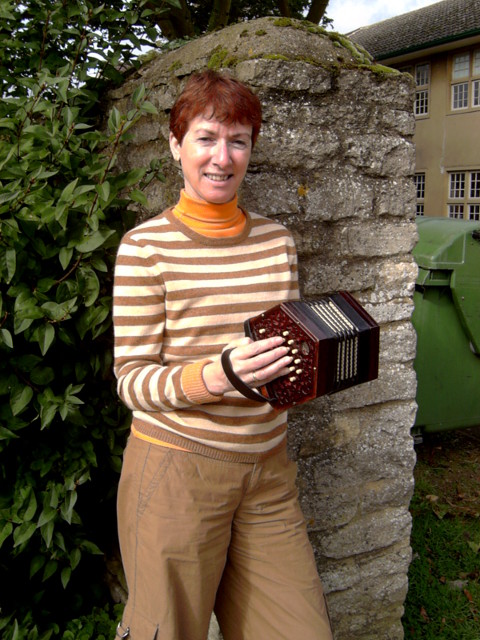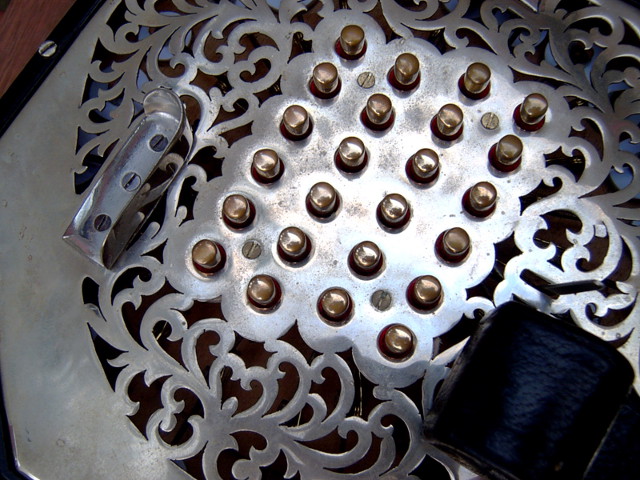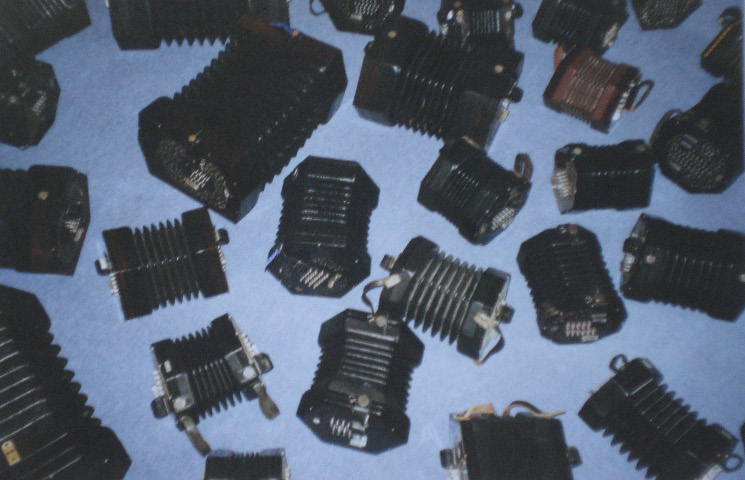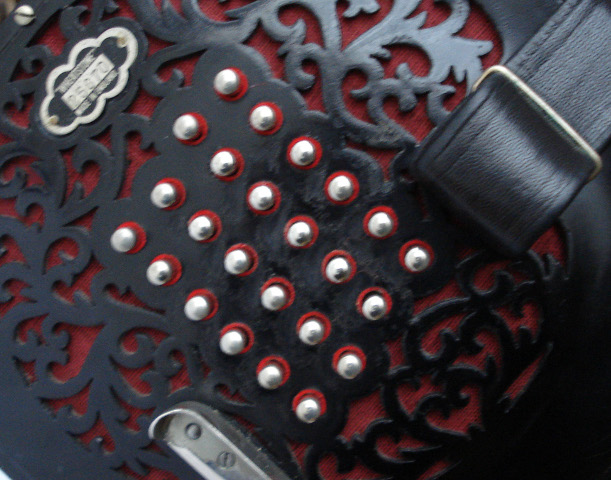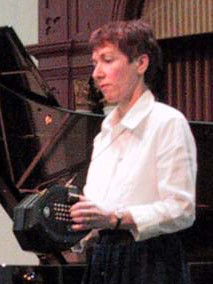For a complete course which consists of a lesson book with explanations and exercises (tunes) plus two play-along cds, including videoclips playable on pc buy the English Concertina tutor
or the Anglo Concertina tutor
Private lessons by Skype possible.
By ear you will learn where the notes are on the instrument and how they sound.
No teacher can actually teach you how to play the concertina, or any other instrument. The only thing your teacher can do is give you advice. How to study and practice.
Doing this you will learn yourself. You always learn yourself. It is not possible for any teacher to put things into your head except by repeating things over and over.
Normally this can not be done within one lesson or workshop. So you yourself have to repeat over and over the things you want or need to learn.
Start with these videos and make gradual progress by repeating the exercise given until it is very familiar and easy to do.
Take your time and do not rush through each lesson because that way you will not learn. Although the lessons are based on a 48 key English Concertina (Pauline de Snoo), a 30 key Anglo Concertina (Johan Verbeek) and a Crane Duet Concertina (Paul McCann), all types of concertinas can use these lessons.
If you have fewer or more buttons you can just do the part in which you can join in. When you have more buttons you can add to the exercise yourself.
Have fun.
Lesson One: First two notes
This first lesson you will begin to play two notes but in different octaves.
Start with finding the G and the E on the left side for E.C.
Play them and name the notes using their absolute name. Also name the notes Soh for G and Me for E.
The sound of the interval (that is the distance between the two notes)
that you hear is a minor third. Do not worry about the exact meaning but just remember this while practicing.
When you have done this also play the G and E on the other side. Again sing along and name the notes.
And more. Look at the video for all the options and if you have them the charts with all the keys for your type of Concertina.
Start with finding the G and the E on the left side for E.C.
Play them and name the notes using their absolute name. Also name the notes Soh for G and Me for E.
The sound of the interval (that is the distance between the two notes)
that you hear is a minor third. Do not worry about the exact meaning but just remember this while practicing.
When you have done this also play the G and E on the other side. Again sing along and name the notes.
And more. Look at the video for all the options and if you have them the charts with all the keys for your type of Concertina.
Lesson Two: First Tune
Having played the two notes from Lesson 1 and being familiar with the names and sound you can continue with this lesson where you will sing and play a little song with these two notes.
Lesson Three: One more note
This time we will begin again with the G and E and add the A.
Listen to the notes and play them.
Name and sing them while playing as before.
Play them and name the notes.
Also name the notes Soh for G, La for A and Me for E..
When you have done this also play the G and E on the right side
and the A on the left for E.C, an octave higher.
Again sing along and name the notes.
Practice all the options in the video.

Listen to the notes and play them.
Name and sing them while playing as before.
Play them and name the notes.
Also name the notes Soh for G, La for A and Me for E..
When you have done this also play the G and E on the right side
and the A on the left for E.C, an octave higher.
Again sing along and name the notes.
Practice all the options in the video.
Lesson Four: Tune 2 with first three notes
When you are familiar with the names and sounds from Lesson 3 you can continue with this lesson where you will play a little song with these notes.
Lesson Five:
You are going to play the tune from Lesson 1 using two new notes.
The absolute names are F and the D, but the relative names are Soh for F and Me for D. Again in different octaves.
After this you know exactly where the first five notes ( D, E, F, G and A) are in different octaves.
The absolute names are F and the D, but the relative names are Soh for F and Me for D. Again in different octaves.
After this you know exactly where the first five notes ( D, E, F, G and A) are in different octaves.
Lesson Six:
Repeat the tune from Lesson 4 with the notes D, F and G in different octaves Name the notes as you play them every time.
Both as absolute names and as Soh for F, Me for the D and La for the G.
This is all meant to train your ear in the best possible way.
Both as absolute names and as Soh for F, Me for the D and La for the G.
This is all meant to train your ear in the best possible way.
Lesson Seven:
A new note in Tune 3; the B and a tune with the notes G, B and D.
The relative names are Soh for D, Me for B and Doh for G.
Sing and play the notes naming them by their absolute and relative names.
For a complete course on English and Anglo Concertina buy the Concertina tutors from which you can learn a lot more.
Private lessons by Skype possible.
The relative names are Soh for D, Me for B and Doh for G.
Sing and play the notes naming them by their absolute and relative names.
For a complete course on English and Anglo Concertina buy the Concertina tutors from which you can learn a lot more.
Private lessons by Skype possible.
Lesson Eight: A new note
the F# (F sharp) and the tune from lesson 7 with the notes D, F# and A.
The relative names are Doh for D, Me for F# and Soh for A.
Sing and play the notes naming them by their absolute and relative names.
Always play in the different octaves as shown in the video.
The relative names are Doh for D, Me for F# and Soh for A.
Sing and play the notes naming them by their absolute and relative names.
Always play in the different octaves as shown in the video.
Lesson Nine: With four notes
Doh for G, Ray for A, Me for B and Soh for D.
Sing and play the notes naming them by their absolute and relative names.
Keep practicing and do repeat your weak spots.
Sing and play the notes naming them by their absolute and relative names.
Keep practicing and do repeat your weak spots.
Lesson Ten:
The same tune as in lesson 9 but with new notes: D, E, F# and A.
The Duet Concertina plays the E, F#, G# and B.
The Duet Concertina plays the E, F#, G# and B.
Lesson Eleven: With six notes
Fiddledede in the key of F.
Sing first with the video, then play the tune.
Sing first with the video, then play the tune.
Lesson Twelve:
Tune 6 (English Round) with again another combination of notes.
Sing first, then play.
Sing first, then play.
Lesson Thirteen:
Now a real folk tune "As the tide was flowing".
Sing with the video and then when you have memorized it you can play it.

Sing with the video and then when you have memorized it you can play it.
Lesson Fourteen:
playing "As the tide was flowing" together.
For a complete course buy the Concertina tutors from which you can learn a lot more.
Private lessons by Skype possible.
For a complete course buy the Concertina tutors from which you can learn a lot more.
Private lessons by Skype possible.
